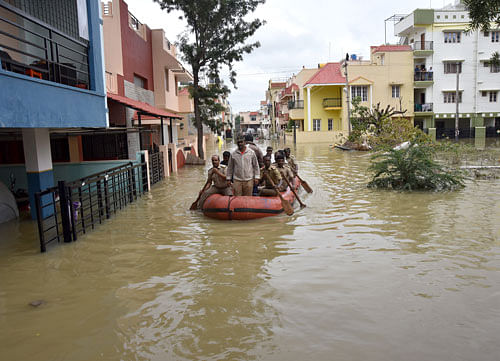
Trapped in floods triggered by breached lakes, as thousands of Bengalureans struggled, the sinister handiwork of the builder-official nexus was out in the open: Canals and lakebeds they encroached had blocked the natural flow of water.
It was an urban disaster foretold, yet ignored by the state machinery. But last week, as four lakes breached and flooded huge swathes of the city, the monster problem was dramatically out in the open: Blatant encroachment of lakebeds and storm water drains, perfected over the years by a well-oiled nexus of builders and civic agency officials.
Trapped in floods of monstrous proportions, residents of areas around Madiwala, Hulimavu, Arakere, Sarakki and Bellandur lakes wondered why a spell of heavy rain troubled them so much. But the big picture soon became clear: The encroached feeder canals that take excess water from one lake to the next were either totally cut off or were just not wide enough.
There was no way anyone could stop the lakes from overflowing as the downpour continued. Cut off from the link drains, the lake water entered residential layouts, flooding streets, houses and vacant sites. Hopelessly marooned, residents in their thousands realised the apartments were either too close to the water bodies or right on the flood path.
Building obstacles
The implication was clear. Builders were allowed to construct multi-storied structures so close to the lakes that even the now stretched 30-metre buffer zone had no meaning. The National Green Tribunal (NGT) had in its recent order extended the zone to 75 metres, but with only prospective effect.
The Bangalore Development Authority (BDA) has carved out many layouts in the vicinity of these lakes. But, as the flooding proved beyond doubt, the layout designs were not in tune with the lake drainage mechanism. Not enough space was allowed for storm water drains.
In Arakere, the BDA-approved Vysya Bank Colony had most of its streets flooded with overflowing water from the lake nearby. Decades after the layout’s formation, the Bruhat Bengaluru Mahanagara Palike (BBMP) is now building an underground drain. In the process, bulldozers are cutting open streets, slicing through cable, electricity, water and sewer lines.
1,923 encroachments
Absolute disregard for rules has aided the encroachment of 1,923 lakes and SWDs. This has been admitted by the civic agencies themselves to the legislature committee headed by Assembly Speaker K B Koliwad, which visited flood-hit areas on Thursday.
But this is a conservative estimate. BBMP officials say only 822 of these obstacles have been removed. A part of the remaining 1,101 encroachments were clearly responsible for the recent floods. The message is clear: Many more such disasters are in the offing if the Palike does not act quickly.
Why was this problem allowed to assume such destructive proportions? Why were the encroachments permitted with impunity, and not cleared before the monsoon? Koliwad himself had an answer: The civic bodies act only against ordinary people and deliberately stop initiating action against builders.
But the builders do not act in isolation. Civic activists, environmentalists, scientists and lake committees have repeatedly exposed the connivance of BDA, BBMP and BWSSB officials and lower-level staff in bending rules.
Fabricating title deeds
This should explain how title deeds were fabricated to build huge apartment complexes on lakebeds and encroached storm water drains. But the sheer audacity of these sinister machinations has stumped many seasoned lake rejuvenation campaigners.
Wonders Dr T V Ramachandra from the Centre for Ecological Sciences, Indian Institute of Science, “How did they manage to get ownership of these lakebeds? Don’t people understand that the lakebeds and wet-lands act as a sponge, not allowing water to flood the surrounding areas?”
Last week’s deluge is the latest proof of what unimaginable destruction this blatant violation of nature’s rules can trigger. As Dr Ramachandra explains, the Hulimavu-Agara-Begur-Madiwala-Bellandur lake chain is part of the Koramangala-Challaghatta Valley along which water once used to flow naturally.
The city’s unbridled growth without proper planning by the BDA and strict monitoring by the BBMP and the Karnataka State Pollution Control Board (KSPCB) has meant only this: The Valley system, once networked seamlessly through feeder canals, wetlands and SWDs, has been thoroughly compromised.
Bengaluru has 850 km of SWDs. Of these, he says, 370 km are now encroached. Illegal take-over of wetlands has been worse. In one violation by a reputed builder that hit national headlines, the wetland stretch between Agara and Bellandur lakes was levelled for a massive realty project.
Desilting issues
Lack of routine desilting is another critical issue. Opposition party leader in the BBMP council, Padmanabha Reddy, he says, had asked the Palike higher officials to desilt all the drains right after the Chennai floods. “However, no action was taken. The silt remains uncleared from SWDs,” observes Reddy.
Former Yediyur councillor N R Ramesh notes that BBMP had spent Rs 9 crore just to conduct the survey of encroachments, but actual work remains incomplete. The civic agency, says he, lacks dedication and is inefficient in work. No action is taken against big builders guilty of encroachments as they are protected by a powerful lobby of politicians and Palike officials. That says it all!